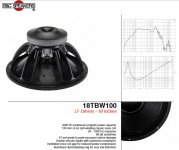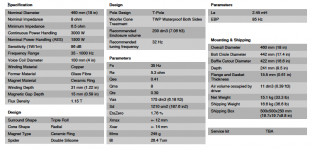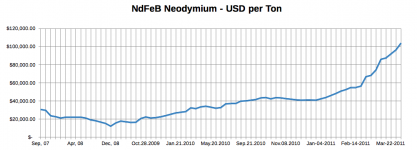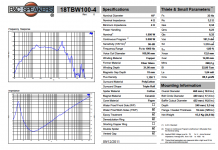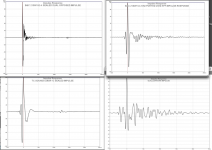Neodymium cost has risen sky high recently, driving the cost of Neo magnet woofers up as well. Charlie Tappa of Pro Sound Service, Inc. is the US distributor of B&C, who make some of the best drivers available.
Pro Sound Service AV Sales Service Install 877-776-7631
Charlie informed me of the new ceramic magnet driver alternative 18” driver from B&C, the 18TBW100. This driver has similar specifications of the neo BC-18SW115 other than the weight, it is 33.3 pounds compared to the neo at 26.2 pounds. It has slightly less Xmax, 12 mm compared to 14, and can handle slightly less power.
Although weight savings is always a good thing, the difference of 7.1 pounds on a 150-200 pound sub is not very noticeable, but the cost difference is:
Pro Sound Service lists the BC-18SW115 at $572.40, the 18TBW100 is listed for $359.99.
Specs for the 4 ohm version are in post #6.
Art
Pro Sound Service AV Sales Service Install 877-776-7631
Charlie informed me of the new ceramic magnet driver alternative 18” driver from B&C, the 18TBW100. This driver has similar specifications of the neo BC-18SW115 other than the weight, it is 33.3 pounds compared to the neo at 26.2 pounds. It has slightly less Xmax, 12 mm compared to 14, and can handle slightly less power.
Although weight savings is always a good thing, the difference of 7.1 pounds on a 150-200 pound sub is not very noticeable, but the cost difference is:
Pro Sound Service lists the BC-18SW115 at $572.40, the 18TBW100 is listed for $359.99.
Specs for the 4 ohm version are in post #6.
Art
Attachments
Last edited:
Just plugged it into my Akabak script of the TH-18 Flat to 35hz! (Xoc1's design)
It sims great hitting Xmax at just over 900w. I may have to order a few! Thanks for the find
http://www.diyaudio.com/forums/subwoofers/190635-th-18-flat-35hz-xoc1s-design.html
It sims great hitting Xmax at just over 900w. I may have to order a few! Thanks for the find
http://www.diyaudio.com/forums/subwoofers/190635-th-18-flat-35hz-xoc1s-design.html
DSL and I use the 18SW115 in long tapped horns with similar pressures to a long straight horn.Are the cones stout enough to handle a 13 foot long air column? One of these years the lab horns will need to be upgraded to something that can take more power. Right now, I don't have it to give, but eventually..... when I just gotta have 10 more dB's....
The 18TBW100 appears to have the same epoxy treated waterproofed both sides cone, it should withstand similar pressures.
The 18TBW100 parameters are quite different from the Lab 12, a redesign of the Labhorn would be required to optimize a front loaded horn for these drivers.
The TC-Epic 12" has parameters more similar to the Lab 12, but far more Xmax (and similar price), it may be more of a "drop in" improvement over the Lab 12.
Art
It was a matter of economics, the days of large inexpensive neo drivers are over for some time.Yeah we need an alternative to these neo drivers. Thank you manufacturers for coming up with options!!
B&C is simply ahead of most manufacturers, and their magnet structure allows for a relative parity between designs using Fe rather than Neo.
JBL, on the other hand, will be hard pressed to make the differential drive work with ceramic, that design will probably only continue in their most expensive flying cabinets, where weight is a real concern.
The 18TBW100 is available in 4 ohm also, spec sheet below.
Attachments
DSL and I use the 18SW115 in long tapped horns with similar pressures to a long straight horn.
The 18TBW100 appears to have the same epoxy treated waterproofed both sides cone, it should withstand similar pressures.
The 18TBW100 parameters are quite different from the Lab 12, a redesign of the Labhorn would be required to optimize a front loaded horn for these drivers.
The TC-Epic 12" has parameters more similar to the Lab 12, but far more Xmax (and similar price), it may be more of a "drop in" improvement over the Lab 12.
Art
I wasn't thinking about a drop-in. I know it would take a whole new design, but for a similar cutoff frequency it's still gotta push just as much air. I spent some time looking around for drivers that could potentially give me 10 more dB for 'the next generation', but I'm skeptical of 18's because I've seen horns rip them to shreds at dB levels below and frequencies above what I can do now. And people around here are even killing 3015's. I've often wondered about the TBX100's which models well, but I'm not yet willing to blow $300+ per driver (and as much on lumber) on such experiments with the good possibility of destroying them. If these are known to withstand this kind of stress, it might be worth building a pair (or quad) to run through their paces. I built those old horns back in 02, and any potential 'upgrade' would have to be worth 10dB through increased power handling in the same form factor to even consider.
The Eminence 4015LF is a stronger, heavier cone than the 3015LF.And people around here are even killing 3015's. I've often wondered about the TBX100's which models well, but I'm not yet willing to blow $300+ per driver (and as much on lumber) on such experiments with the good possibility of destroying them. If these are known to withstand this kind of stress, it might be worth building a pair (or quad) to run through their paces.
In my Keystone TH, the 4015LF was so distorted at full power (even though it did not exceed Xmax) that I did not measure distortion due to cone flex, I have tested it at full power in a ported cabinet and it was clean.
Lab 12s are far stronger than the 4015LF, but had more distortion at full power (and excursion) than the B&C18SW115. The B&C18SW115 did not get warm in full power testing, the Lab12s showed signs of thermal compression, and were hot to the touch, not a good feature when sealed in a tiny compression chamber.
LF output is all about displacement, the size of the speaker makes no difference as long as it can move the same amount of air without burning up.
If the BC18TBW100 is as immune to thermal problems as it's Neo brother, a pair would be a big upgrade from a pair of Lab 12", with power compression figured in, 10dB more output would probably be close to reality.
Art
Lab 12s are far stronger than the 4015LF, but had more distortion at full power (and excursion) than the B&C18SW115. The B&C18SW115 did not get warm in full power testing, the Lab12s showed signs of thermal compression, and were hot to the touch, not a good feature when sealed in a tiny compression chamber.
LF output is all about displacement, the size of the speaker makes no difference as long as it can move the same amount of air without burning up.
If the BC18TBW100 is as immune to thermal problems as it's Neo brother, a pair would be a big upgrade from a pair of Lab 12", with power compression figured in, 10dB more output would probably be close to reality.
Art
The above in a TH or ported cab?
Sam,The above in a TH or ported cab?
Yes
I have tested the B&C and Eminence drivers in ported and tapped horn enclosures, the Keystone is a tapped horn.
The Eminence 4015LF was so obviously distorted in the Keystone at full power (even though it did not exceed Xmax) that I did not bother to measure distortion.
The 4015LF distortion at full power in a ported cabinet was very low.
The Lab 12s are far stronger than the 4015LF, but still had more distortion at full power than the B&C18SW115 in the tapped horn.
The pair of Lab 12s were given 800 watts, the B&C18SW115 1500 watts.
Although the pair of Lab 12s were slightly more sensitive, due to thermal compression the B&C18SW115 outperformed them by a good margin at high power levels.
Art
B&C is one of the few that measures Xmax as 10% THD (as specified by AES2-1984 (r2003) for T/S parameters).
B&C SPEAKERS
Which is unlike most that uses Xmax = [(winding depth - magnetic gap depth) / 2] + (magnetic gap depth / 3) or similar.
Which could lead to BS values like for FaitalPro W8N8-200 FaitalPRO - Professional Loudspeakers Made in Italy
Where Xdamage is less than Xmax. Not a bad driver but I would say that the 8.48mm Xmax is false marketing.
B&C SPEAKERS
Which is unlike most that uses Xmax = [(winding depth - magnetic gap depth) / 2] + (magnetic gap depth / 3) or similar.
Which could lead to BS values like for FaitalPro W8N8-200 FaitalPRO - Professional Loudspeakers Made in Italy
Where Xdamage is less than Xmax. Not a bad driver but I would say that the 8.48mm Xmax is false marketing.
Not only are B&C's Xmax figures conservative, their Xmech figures are real too.B&C is one of the few that measures Xmax as 10% THD (as specified by AES2-1984 (r2003) for T/S parameters).
B&C SPEAKERS
Which is unlike most that uses Xmax = [(winding depth - magnetic gap depth) / 2] + (magnetic gap depth / 3) or similar.
Which could lead to BS values like for FaitalPro W8N8-200 FaitalPRO - Professional Loudspeakers Made in Italy
Where Xdamage is less than Xmax. Not a bad driver but I would say that the 8.48mm Xmax is false marketing.
I have listened to the BC18SW115 while a 20 Hz sine wave drove it to 50mm peak to peak travel, the suspension only made a slight clicking sound.
It was funny to put golf balls on the cone and watch them fly
Art
Hey Art I had some fun redoing some earlier outdoor measurements on my pair of the 21sw152-4's in a 5.5 cubic foot sealed airspace last weekend. I put it up the data on the site yesterday. Thought you might be interested since you have the little brothers.
This drive is probably another winner from B&C.
This drive is probably another winner from B&C.
I used the B&C 18PS100 in a subwoofer for my home. It's in a ported 7cuft cabinet. Driver Fs is 30Hz, 95dB sensitivity.
B&C SPEAKERS
I use a lot of their drivers. I've bought many of them from Prosound service.
B&C SPEAKERS
I use a lot of their drivers. I've bought many of them from Prosound service.
Josh,Hey Art I had some fun redoing some earlier outdoor measurements on my pair of the 21sw152-4's in a 5.5 cubic foot sealed airspace last weekend. I put it up the data on the site yesterday. Thought you might be interested since you have the little brothers.
This driver is probably another winner from B&C.
I hope B&C also comes out with a slab magnet 21", the BC 21SW152 models well in the Keystone design, it would be fun to have a louder and lower cabinet of the same size, but I can't afford the Neo prices anymore.
In conversations with Ivan Beaver he mentioned how the B&C 18SW115 had a bit more "punch" than the equivalent 18Sound driver in the same DSL TH-118.
Looking at the impulse response of the BC 21SW152 compared to the LMSR 12", the dual 21s show less ringing, and no "pre-ring".
Do you think sub woofer "punch factor" is related to impulse response?
Is the impulse response of the sealed cabinets due to the cabinet design, speaker design, or both?
What causes an impulse to start before "0" ms ?
Art
Attachments
I have listened to the BC18SW115 while a 20 Hz sine wave drove it to 50mm peak to peak travel, the suspension only made a slight clicking sound.
This type of info should be in every review about drivers.
Have you ever experienced a "noisy" B&C driver?
Like turbulence or "farting" sound from the cooling?
The two RCF LF15G401 I had where very noisy and made a farting sound that was obnoxious at best. Worked ok though for a TH flown 5m in the air.
Josh,
I hope B&C also comes out with a slab magnet 21", the BC 21SW152 models well in the Keystone design, it would be fun to have a louder and lower cabinet of the same size, but I can't afford the Neo prices anymore.
In conversations with Ivan Beaver he mentioned how the B&C 18SW115 had a bit more "punch" than the equivalent 18Sound driver in the same DSL TH-118.
Looking at the impulse response of the BC 21SW152 compared to the LMSR 12", the dual 21s show less ringing, and no "pre-ring".
Do you think sub woofer "punch factor" is related to impulse response?
Is the impulse response of the sealed cabinets due to the cabinet design, speaker design, or both?
What causes an impulse to start before "0" ms ?
Art
Truthfully Art I probably need to go back and repost some of the impulse graphs. There are some that are probably not of a signal covering the same frequency range. If one impulse is from a measurement that stops at 200Hz and another goes to 2Khz that alone will make quite a big difference. I have measurements for everything that extend to 125Hz, 200Hz, 300Hz and occasionally higher to a couple of Khz. Since everything needs to be apples vs apples and we are talking pure bass range testing I think that 200Hz seems like the most reasonable cutoff. On these the impulse peak is centered.
- Status
- This old topic is closed. If you want to reopen this topic, contact a moderator using the "Report Post" button.
- Home
- Loudspeakers
- Subwoofers
- New Lower Cost B&C 18"
